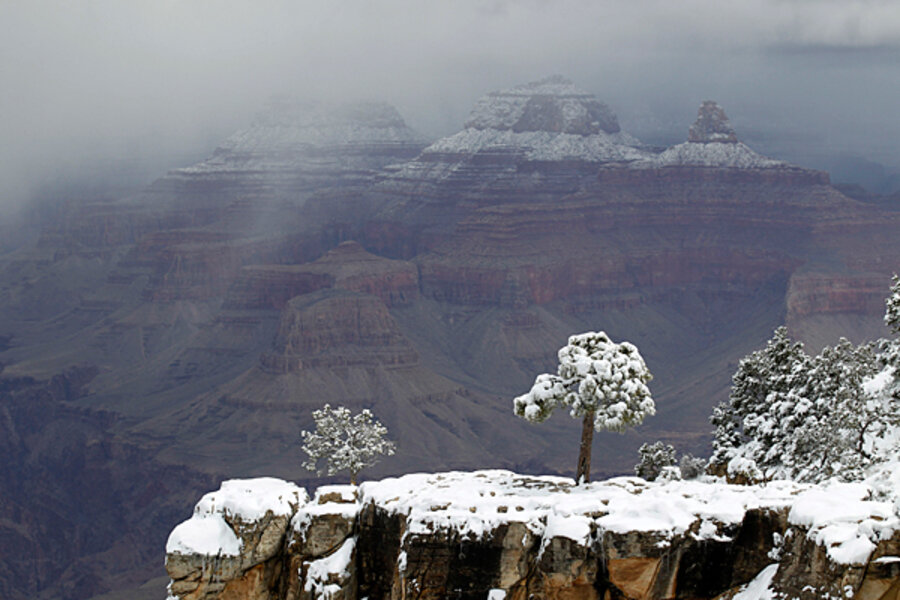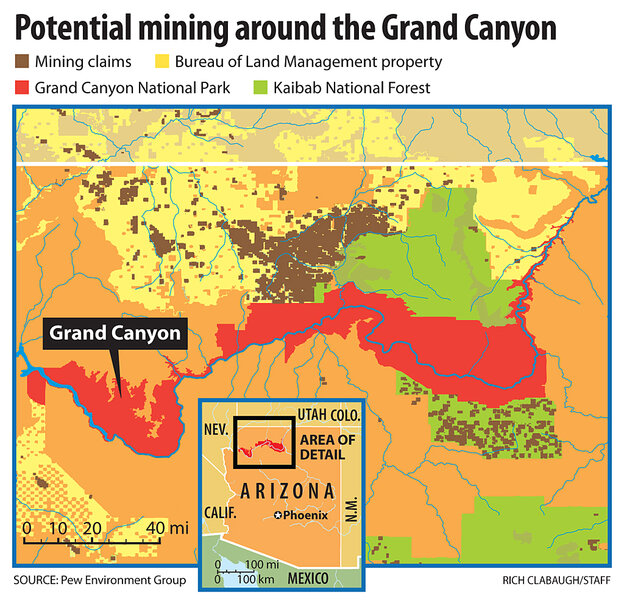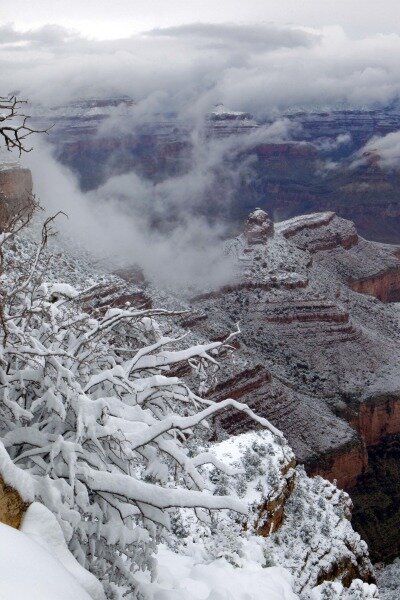Time to lift ban on uranium mining near Grand Canyon? Deadline nears.
Loading...
In the past decade, interest in mining for uranium has surged, with prices for the metal soaring in world markets a few years ago. Uranium prospecting and mining-project plans have been popping up like jack rabbits across the western United States.
But for at least one of America's iconic natural landmarks, the Obama administration has put the brakes on thousands of new mining plans or claims. In 2009, it blocked claims for uranium and other mining on about 1 million acres of public land bordering the Grand Canyon.
Now, the administration is nearing a decision point: whether to allow the mining-claims process to move forward or extend its moratorium for up to 20 years. The decision could set a precedent for other natural landmarks also being hedged in by uranium and other mining claims, observers say.
More than 8,300 uranium and other mining claims, their development frozen by the government moratorium, are staked on the public lands near the Grand Canyon, according to a new study by the Pew Environment Group, an environmental watchdog based in Washington, D.C.
The report labels the Grand Canyon, as well as nine other national "treasures" in the West, as "at risk" from surging industrial mining claims on nearby public lands. More than 4,400 mining claims have been staked near those nine other sites.
In the middle of the storm is the Department of Interior's Bureau of Land Management (BLM), which controls much land around the 10 sites. Also getting involved is Congress, which is unhappy about growing foreign ownership of many uranium mining claims and a lack of revenue for the government from any resulting mines. The legislation regulating these activities needs updating, say some lawmakers.
As for the Grand Canyon, environmentalists and water managers from Los Angeles to Las Vegas decry any uranium mining near the landmark, citing visual impacts, flash floods, and radioactivity leaching into ground water that feeds the vital Colorado River.
"These are national parks and other special places Americans hold dear – and they're now at risk thanks to mining claims staked in close proximity to them," says Jane Danowitz, director of the Pew public-land program that produced the report. "It's all due largely to the fact that we have this outdated mining law, so anyone who wants to mine and take minerals from US soil can do it no matter how much damage it does."
Such fears are overblown, industry experts say, with predictions of only 1 in 10 mining claims, if that, being developed into a mine.
"The uranium mining industry in this area has had a stellar environmental track record," says Pamela Hill, executive director of the American Clean Energy Resources Trust, a coalition of uranium exploration and mining companies based in Kanab, Utah. "A lot of these concerns are without basis in science or history of uranium mining in this area."
May 4 will mark the end of a public-comment period on the environmental impact statement that has been drawn up about mining by the Grand Canyon. A decision by the government on whether to lift its moratorium is expected by July 20.
Even with the Obama administration's moratorium, one mining claim near the Grand Canyon, deemed to have existing rights, was allowed to go forward, and a mine is now in operation. Also, as many as 11 existing uranium claims near the Grand Canyon could be eligible for permits whether or not newer claims are blocked, the BLM says.
Although the Obama administration has not blocked mining claims in other areas, such claims are just starting to reach fruition. Earlier this month, a uranium mine in Wyoming announced its opening. Other sites are expected to be developed, too, according to the Nuclear Regulatory Commission (NRC).
Congress has been watching closely. Some lawmakers have zeroed in on the 1872 Mining Law, under which the US government does not receive any mineral royalties.
Earlier this month, legislation was introduced by Reps. Martin Heinrich and Ben Ray Luján, both Democrats from New Mexico, to shift regulation of uranium mining from "the antiquated 1872 Mining Law" to the Mineral Leasing Act. The latter would allow uranium mining to be managed through a competitive leasing program.
Others also worry that most of America's best uranium mining prospects – including those by the Grand Canyon – are now controlled by Canadian, Korean, Russian, and other foreign companies. In November, the NRC approved transfer of control of licenses from Uranium One USA Inc. and Uranium One Americas Inc., which are Canadian entities, to JSC Atomredmetzoloto (ARMZ), a Russian corporation.
"This transaction would give the Russian government control over a sizable portion of America's uranium production capacity," complained Sen. John Barrasso (R) of Wyoming in a December letter to President Obama. Russia has aided Iranian nuclear ambitions, he wrote.
"I remain concerned with any attempt to grant an export license to ARMZ which would allow the Russian government to ship US uranium overseas," Senator Barrasso added.
Gregory Jaczko, chairman of the NRC, assured Barrasso in a letter that ARMZ had not applied for an export license, so it could not send any US uranium overseas.
In the March 21 letter, Mr. Jaczko also touts expected robust growth in US uranium mining, despite the Fukushima crisis in Japan.
"We are now expecting as many as 16 new applications by 2013 for new recovery facilities or for expanding existing uranium recovery facilities, in addition to those we have already received," he wrote.
One key reason that new US uranium production is needed, Ms. Hill and other advocates say, is to lessen US dependence on foreign energy. About 90 percent of uranium fuel for US nuclear plants today is imported.
But according to a draft BLM study of uranium mining impacts on the Grand Canyon, such mining would do little to boost domestic uranium supplies.
"Currently there are no laws in place that would require domestic uranium to be solely purchased and consumed within the United States," the draft BLM study concluded. "Uranium mined and produced within the parcels would not necessarily move the United States toward energy independence and thus would not represent an impact to national energy resources."







